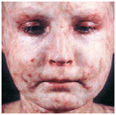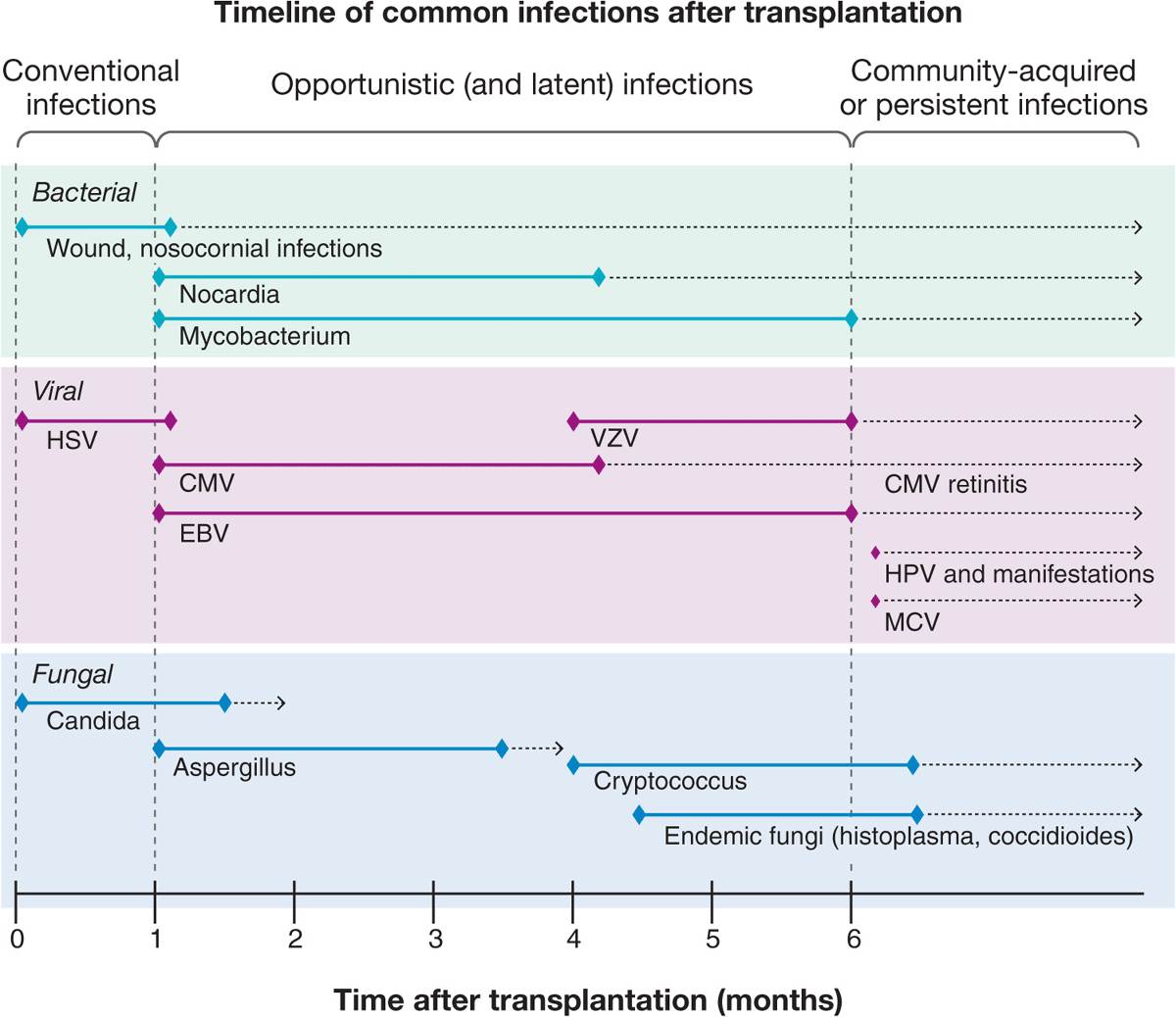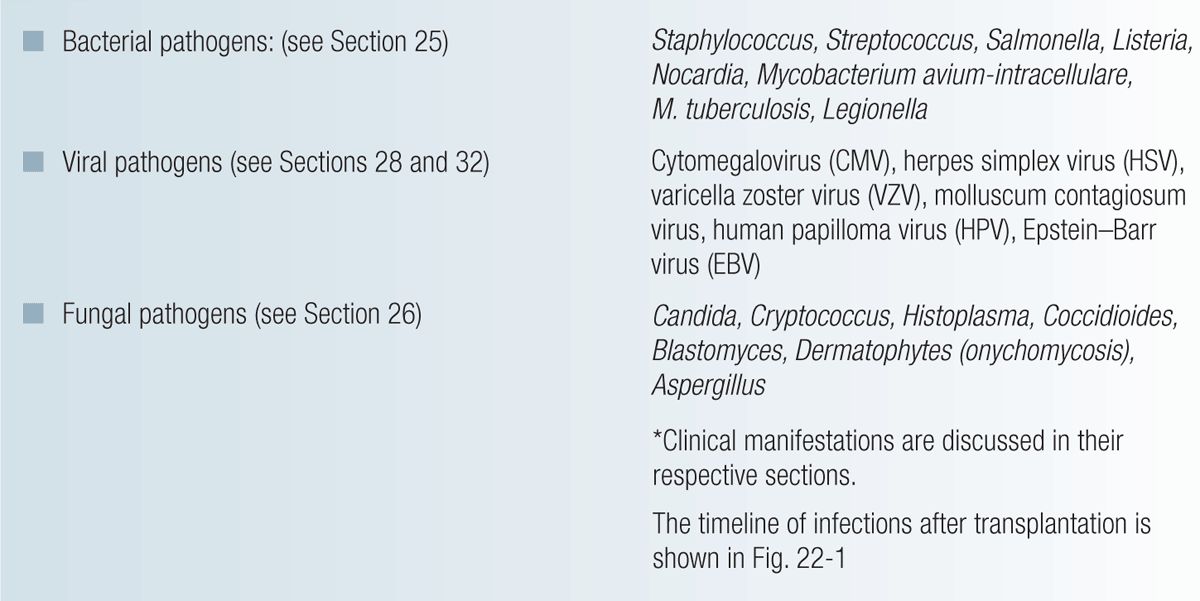Skin Diseases in Organ and Bone Marrow Transplantation 
Organ transplant recipients are chronically immunosuppressed and their T cell function is impaired. Ensuing diseases are mostly infections and are similar to those occurring in other conditions associated with T cell impairment, such as AIDS. In addition, organ transplant recipients are at great risk for developing nonmelanoma skin cancer and other cancers. Bone marrow and stem cell graft recipients are candidates for graft-versus-host disease (GVHD).
Timeline of common infections after transplantation

Figure 22-1. Timeline of common infections after transplantation.
Skin Cancers Associated with Organ Transplantation* 
 Nonmelanoma skin cancer is the most common malignancy in adult solid organ transplant patients.
Nonmelanoma skin cancer is the most common malignancy in adult solid organ transplant patients.
 The majority are squamous cell carcinomas (SCC) (Section 11).
The majority are squamous cell carcinomas (SCC) (Section 11).
 The risk of developing SCC increases exponentially with the length of immunosuppression.
The risk of developing SCC increases exponentially with the length of immunosuppression.
 The cumulative incidence is 80% after 20 years of immunosuppression in renal transplantation. SCC in posttransplant patients are aggressive.
The cumulative incidence is 80% after 20 years of immunosuppression in renal transplantation. SCC in posttransplant patients are aggressive.
 HPV infection is implicated in the pathogenesis.
HPV infection is implicated in the pathogenesis.
 Other epithelial proliferative lesions are actinic keratoses, keratoacanthomas, porokeratosis, appendage tumors, and Merkel cell carcinomas (Section 11).
Other epithelial proliferative lesions are actinic keratoses, keratoacanthomas, porokeratosis, appendage tumors, and Merkel cell carcinomas (Section 11).
 Children with organ transplants may also be at higher risk for the development of melanoma (Section 12).
Children with organ transplants may also be at higher risk for the development of melanoma (Section 12).
 Lymphoproliferative disorders are common in graft recipients and related to Epstein–Barr virus-mediated proliferation of B cells and most are lymphomas of B cell origin. Cutaneous T cell lymphomas account for 30% of cutaneous lymphomas in transplant patients (Section 21).
Lymphoproliferative disorders are common in graft recipients and related to Epstein–Barr virus-mediated proliferation of B cells and most are lymphomas of B cell origin. Cutaneous T cell lymphomas account for 30% of cutaneous lymphomas in transplant patients (Section 21).
 Kaposi sarcoma occurs in immunosuppressed transplant recipients with an incidence of 0.5–5%. All cases are associated with Kaposi sarcoma-associated herpesvirus (KSHV) infection (Section 21).
Kaposi sarcoma occurs in immunosuppressed transplant recipients with an incidence of 0.5–5%. All cases are associated with Kaposi sarcoma-associated herpesvirus (KSHV) infection (Section 21).
*Clinical manifestations are discussed in their respective sections.
Graft-Versus-Host Disease ICD:9: 996.85  ICD-10: T86.0
ICD-10: T86.0 
 GVHD is the totality of organ dysfunction caused by the action of histoincompatible, immunocompetent donor cells against the tissues of an immunocompetent host.
GVHD is the totality of organ dysfunction caused by the action of histoincompatible, immunocompetent donor cells against the tissues of an immunocompetent host.
 Graft-versus-host reaction (GVHR) is the expression of GVHD in a specific organ (e.g., cutaneous GVHR).
Graft-versus-host reaction (GVHR) is the expression of GVHD in a specific organ (e.g., cutaneous GVHR).
 Acute cutaneous GVHR, usually occurring 10–30 days after bone marrow transplantation (BMT). It is the earliest and most frequent GVHR. Liver and GI tract GVHR are also common.
Acute cutaneous GVHR, usually occurring 10–30 days after bone marrow transplantation (BMT). It is the earliest and most frequent GVHR. Liver and GI tract GVHR are also common.
 Chronic cutaneous GVHR occurs >60 days after allogeneic BMT and manifests as lichenoid and sclerodermoid changes.
Chronic cutaneous GVHR occurs >60 days after allogeneic BMT and manifests as lichenoid and sclerodermoid changes.
 Incidence. Allogeneic BMT: 20–80% of successful engraftments. Autologous BMT: mild cutaneous GVHR occurs in 8%. Low incidence after blood transfusion in immunosuppressed patients, maternal-fetal transfer in immunodeficiency disease.
Incidence. Allogeneic BMT: 20–80% of successful engraftments. Autologous BMT: mild cutaneous GVHR occurs in 8%. Low incidence after blood transfusion in immunosuppressed patients, maternal-fetal transfer in immunodeficiency disease.
Related
Related posts:
Stay updated, free articles. Join our Telegram channel

Full access? Get Clinical Tree










